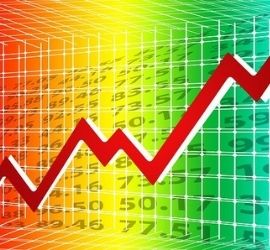VWAP – Volume Weighted Average Price Definition
 Volume-Weighted Average Price (VWAP) is exactly that – the average price weighted by volume. VWAP equals the dollar value of all trading periods divided by the total trading volume for the current day. The calculation starts when trading opens and ends when it closes. Because it is good for the current trading day only, intraday periods and data are used in the calculation. VWAP is used to identify liquidity points. As a volume-weighted price measure, it reflects price levels weighted by volume. This can help institutions with large orders. The idea is not to disrupt the market when entering large buy or sell orders. VWAP helps these institutions determine the liquid and illiquid price points for a specific security over a very short time period.
Volume-Weighted Average Price (VWAP) is exactly that – the average price weighted by volume. VWAP equals the dollar value of all trading periods divided by the total trading volume for the current day. The calculation starts when trading opens and ends when it closes. Because it is good for the current trading day only, intraday periods and data are used in the calculation. VWAP is used to identify liquidity points. As a volume-weighted price measure, it reflects price levels weighted by volume. This can help institutions with large orders. The idea is not to disrupt the market when entering large buy or sell orders. VWAP helps these institutions determine the liquid and illiquid price points for a specific security over a very short time period.
Volume is important. No one wants to get stuck with a stock that has few interested buyers. Even though if it looks like a bargain from price alone. Thus, the VWAP was created to take into account both volume as well as price. This is to help a potential investor to make a better-informed trading decision. In simple terms, the Volume Weighted Average price is the cumulative average price with respect to the volume.
VWAP can also be used to measure trading efficiency. After buying or selling a security, institutions or individuals can compare their price to VWAP values. A buy order executed below the VWAP value would be considered a good buy. This is because the security was purchased at a below-average price. Conversely, a sell order executed above the VWAP would be deemed a good transaction. This is because it was sold at an above-average price.
What is the Volume Weighted Average Price (VWAP)?
The volume-weighted average price is a trading benchmark used by traders that gives the average price the security has traded throughout the day, based on both volume and price. This is important because it provides traders with insight into both the trend and value of the security in question. The weighted-price average is a key indicator and guideline for institutions and pension plans that look to take large positions and need to know whether they are getting in at a good price or not. It also allows them to get into positions without disrupting the market or elevating prices unnaturally with their large orders, resulting in unfavorable entry prices for them.
- Readily available – The volume-weighted average price appears as a single line on intraday charts similar to how a moving average appears.
- Key indicator – Retail and professional traders may use the VWAP as part of their trading rules for determining intraday trends.
The Formula for the Volume Weighted Average Price (VWAP)
VWAP is calculated by adding up the dollars traded for every transaction (price multiplied by the number of shares traded) and then dividing by the total shares traded. The formula for calculating volume-weighted price:
VWAP = (Cumulative (Price * Volume)) / (Cumulative Volume)
How to Calculate Volume Weighted Average Price
To calculate the VWAP yourself, follow these steps. Assume a 5-minute chart. The calculation is the same regardless of what intraday time periods are used.
- Calculate average price for the period – Find the average price the stock traded at over the first five-minute period of the day. To do this, add the high, low, and close, then divide by three. Multiply this by the volume for that period. Record the result in a spreadsheet, under column PV.
- Divide by volume for the period – Divide PV by the volume for that period. This will give the VWAP value.
- Add the PV value from each period to the prior values – To maintain the volume-weighted value throughout the day, continue to add the PV value from each period to the prior values. Divide this total by total volume up to that point. To make this easier in a spreadsheet, create columns for cumulative PV and cumulative volume. Both these cumulative values are divided by each other to produce the volume-weighted price.
What Does Volume Weighted Average Price (VWAP) Tell You?
The Volume Weighted Average Price is simple to calculate and has a variety of uses. A Hedge Fund or Mutual fund uses it to guide their decision while buying a substantial number of shares. Retail traders would use it to check if the price at which he traded was a good price or not. There are also intraday traders who will use it as an indicator and buy when the price is below the VWAP.
- Large institutional buyers and mutual funds use the ratio to help move into or out of stocks with as small of a market impact as possible. Therefore, when possible, institutions will try to buy below the weighted-average price, or sell above it. This way their actions push the price back toward the average, instead of away from it.
- Traders may use VWAP as a trend confirmation tool and build trading rules around it. For example, when the price is above the weighted average they may prefer to initiate long positions. When the price is below the weighted average they may prefer to initiate short positions.
- Intraday traders who will use it as an indicator and buy when the price is below the weighted-average.
Trade execution strategy using VWAP
Institutional buyers who need to buy or sell a large number of shares do not want to cause a spike in the volume. A price spike can attract attention and affect the price.
To explain this further, let’s say an institution is interested in buying 10000 shares of Tesla. If it puts an order of 10,000, the immediate action would be a spike in the price as the exchange fills the order. Now, if other traders know that there is a big demand for the share, they would try to buy the share at a higher price than the bid price of the institution and sell it back at a higher price, effectively increasing the asking price of the share. To avoid this scenario, these institutions develop an automated trading strategy to divide the number of shares into smaller amounts and bid for the shares in such a way that their trades do not let the closing prices go far from the VWAP. Since VWAP acts as a guideline on which certain traders base their trading decisions on, it helps to keep the closing price as close to the VWAP as possible. (Source: blog.quantinsti.com)
VWAP as an Indicator
Among intraday traders, the indicator can be used in a trading strategy too. There are conflicting theories on how exactly you should use the VWAP as an indicator.
We usually consider scenarios when the closing price crosses the VWAP as a signal, and thus, a VWAP cross can be used to enter or exit the trade depending on your risk profile. Before we look at the different scenarios, let’s step back and understand that VWAP can actually be self-fulfilling when it comes to traders. As seen previously, certain institutional traders would try to execute trades in such a way that the closing price doesn’t go farther than the VWAP. This can influence other traders who would look at the closing price and take a trading decision thinking that the closing price is bound to get close to the VWAP eventually. Hence, when the closing price starts moving up and farther from the VWAP, there is pressure among the traders to sell, due to the logic that the other would sell at any time. This creates a situation where the general belief might be that the stock is overvalued. Similarly, when the closing price starts moving down and further from the VWAP, there is a belief that the stock is undervalued and there is pressure among traders to buy the stock. In this way, we can call VWAP as self-fulfilling. Of course, depending on the mindset of the community, there can be different scenarios and thus, one cannot depend on VWAP alone to make a trading decision.
Let us now look at a few other scenarios. Some traders prefer the VWAP cross as an indicator and buy the stock when the closing price crosses the VWAP and climbs higher, indicating a bullish trend. One will then either wait for the closing price to reach the high of the day at which point they sell and exit the trade. Other traders will exit as soon as the closing price shows signs of reversing. At the other end, some traders would short the stock when the closing price crosses the VWAP and keeps going down. Once the closing price reaches the low of the day, they would then close the trade. Now, some traders would prefer a price below VWAP as a good price to buy and a price above VWAP could indicate that it is a good time to sell. Taking the previous VWAP chart for Tesla, you can see as the price goes above the VWAP there is a small period where the price keeps increasing, and then the price decreases. It is however seen that for the trading strategy, traders consider the crossover of the closing price with the VWAP as a signal. However, one should note that the VWAP lags behind the closing price and thus should not be the sole indicator in a trading strategy. (Source: blog.quantinsti.com)
Verification of Profitability using VWAP
Once traders ave closed their trade, they can look at the VWAP to check if their trade was profitable or not. For example, say a trader bought 10k shares of APPL at $100 and the VWAP at the end of the day was $115. Then the trader can actually verify that he bought the stock at a good price well below the average price.
The Difference Between Volume Weighted Average Price and a Simple Moving Average
On a chart, VWAP and a moving average may look similar. These two indicators are calculating different things.
- VWAP starts fresh at the open each day – The moving average contains past data. Thus, while the moving average would be similar to VWAP at the end of the day, it will not be the same throughout the day. The volume-weighted average is calculating the sum of price multiplied by volume, divided by total volume.
- A moving average is calculated by summing up closing prices over a certain period, for example, 10. Then divide it by how many periods there are, in this case, 10. Volume is not factored in.
Limitations of Using Volume Weighted Average Price
VWAP is a single-day indicator and is restarted at the open of each new trading day. Attempting to create a volume-weighted average over many days could mean that the average becomes distorted from the true reading. Some institutions may prefer to buy when the price of a security is below the VWAP, or sell when it is above. But, the weighted average price is not the only factor to consider. In strong uptrends, the price may continue to move higher for many days without dropping below the VWAP at all or only occasionally. Therefore, waiting for the price to fall below the weighted average price could mean a missed opportunity if prices are rising quickly. There are also cases where certain stocks are in a strong bullish phase.
As a result, there may be no crossovers for the entire day. This, in turn, portrays very little information to the traders as well as institutions. In a way, the major drawback of VWAP is it cannot be used for more than a day. As a result, it is not able to provide much information beyond a specific trading day. VWAP is based on historical values and does not directly possess predictive data. Because VWAP is anchored to the opening price range of the day, the indicator increases its lag as the day goes on. For this reason, a 1-minute period VWAP calculation after 330 minutes will often resemble a 390-minute moving average at the end of the trading day.
In Summary
VWAP is a great technical indicator because it accounts for both price AND volume. Unlike moving averages, VWAP assigns more weight to price points with high volume. This allows traders to understand price points of interest, gauge relative strength, and identify entry and exit points. VWAP serves as a reference point for prices for one day. As such, it is well suited for intraday analysis.
- Trends – Chartists can compare current prices with the VWAP values to determine the intraday trend.
- Relative value – VWAP can also be used to determine relative value. Prices below VWAP values are relatively low for that day or that specific time. By contrast, prices above VWAP values are relatively high for that day or at that specific time.
- Cumulative indicator – VWAP is a cumulative indicator, which means the number of data points progressively increases throughout the day.
VWAP resets every morning ahead of the opening bell at 9:30 am EST. What may have been a good price yesterday, can turn out to be a lousy price today.
Up Next: Reg E – What is Regulation E: Electronic Funds Transfer Act
Regulation E, also known as Reg E is a regulation put forth by the Federal Reserve Board. It outlines rules and procedures for electronic funds transfers (EFTs). It also provides guidelines for banks and issuers of electronic debit cards. The Federal Reserve System is the U.S. government’s central bank. The Fed was created by Congress in 1913 to provide the nation with a more stable monetary system. Reg E is in place for banks, financial institutions, and consumer protection. Regulation E includes the rules governing electronic fund transfers or EFTs. It also provides guidance to banks and other institutions that issue electronic debit cards.



